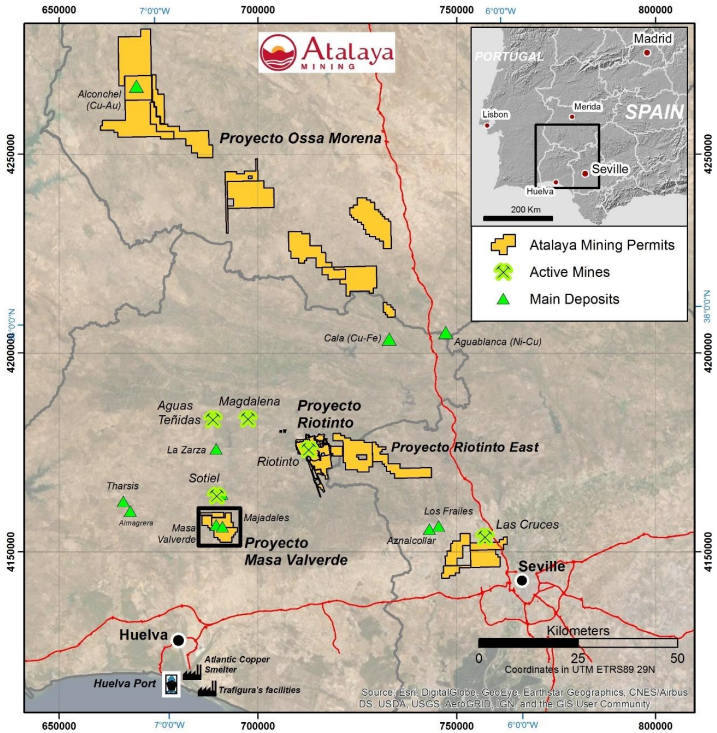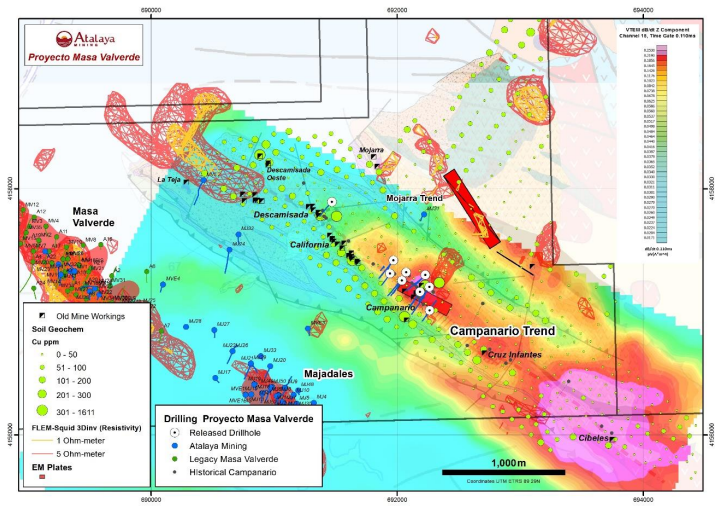Atalaya Mining (TSX:AYM) has announced results from the first 22 exploration drill holes completed to date at the Campanario Trend. This is one of several mineralized zones comprising Proyecto Masa Valverde, located in Southern Spain. It is roughly 28 kilometres south of Atalaya’s 15 Mtpa mill at Proyecto Riotinto.
CEO of Atalaya Mining Alberto Lavandeira commented in a press release: “We are pleased with these initial drilling results from the Campanario Trend which confirm the expectations we had on the exploration potential of PMV. We continue working on defining the potential shallow mineral resource in the short term which to date has only been drill tested in approximately 10% of the entire mineralised structure. In addition, we have several coincident geochemical and geophysical targets pending for drill testing indicating that we are still far from knowing the ultimate exploration potential of PMV. We believe that these initial results will not only have a positive impact on future development scenarios and project economics, but they also highlight the significant exploration potential of the Iberian Pyrite Belt.”
Figure 1: Proyecto Masa Valverde Location

Highlights from the drill results are as follows:
- Initial drilling results confirm PMV’s continued exploration potential and the possibility to quickly define a shallow mineral resource
- Shallow polymetallic mineralisation includes:
- CA15: 35.20m at 0.70% Cu, 1.53% Zn, 1.39% Pb and 62.50 g/t Ag (1.71% CuEq) from 77.80m from surface
- CA21: 18.10m at 1.19% Cu, 0.08% Zn, 0.32% Pb and 36.66 g/t Ag (1.40% CuEq) from 43.20m from surface
- Drilling to date has focused around the historical Campanario workings, which only represents approximately 10% of the entire strike length of the mineralised structure
- Intersected mineralisation includes massive and semi-massive sulphides as well as stockwork-type material, consistent with the Masa Valverde and Majadales deposits
- Initial drilling results demonstrate the significant exploration potential of Atalaya’s strategic land package in the world-class Iberian Pyrite Belt
About Proyecto Masa Valverde
PMV consists of several volcanogenic massive sulphide (“VMS”) type deposits including Masa Valverde, Majadales, the Campanario Trend and other drill ready targets. Atalaya’s exploration team discovered the Majadales deposit and in 2020 acquired a 100% interest in PMV. The project is strategically located approximately 28 km from Proyecto Riotinto, therefore future development scenarios are expected to utilise the Company’s existing 15 Mtpa processing plant.
In April 2022, Atalaya announced a new independent resource estimate for PMV that was prepared in accordance with CIM guidelines and disclosure requirements of NI 43-101, including:
- Masa Valverde Indicated Mineral Resource of 16.9 Mt at 0.66% Cu, 1.55% Zn, 0.65% Pb, 27 g/t Ag and 0.55 g/t Au (1.51% CuEq)
- Masa Valverde Inferred Mineral Resource of 73.4 Mt at 0.61% Cu, 1.24% Zn, 0.61% Pb, 30 g/t Ag and 0.62 g/t Au (1.37% CuEq)
- Majadales Inferred Mineral Resource of 3.1 Mt at 0.94% Cu, 3.08% Zn, 1.43% Pb, 54 g/t Ag and 0.32 g/t Au (2.55% CuEq)
Atalaya expects to complete a PEA for PMV by the end of the year.
Four rigs are currently operating at PMV, as part of the Company’s €10 million exploration programme for 2022. Two rigs are devoted to the Campanario Trend and the rest are drill testing the Fix Loop Electromagnetic (“FLEM”) anomalies west of the Masa Valverde deposit. So far, three holes were completed at two of the FLEM anomalies. The results of that programme will be released in a future announcement.
About the Campanario Trend
The Campanario Trend is a five kilometre north-west trending mineralised corridor, located one kilometre north of the Masa Valverde and Majadales VMS deposits. Campanario is characterised by the presence of numerous small historical workings and coincident soil geochemical and geophysical anomalies (see Figure 2 in the Website Announcement).
Figure 2: Campanario Trend Anomalies

Historical mining activity (from 1876 – 1917) along the Campanario Trend was at a small scale and focused on narrow zones of massive sulphides. Near-surface oxidation of the massive sulphides, mainly pyrite, generated gossans which were also investigated for gold potential.
Total historical mine production is estimated to be 0.22 million tonnes at 1.5% Cu from six main mining areas situated from the east to the west: Cruz Infante, Cibeles, Campanario, California, Descamisada and Descamisada Oeste. Drilling to date by Atalaya has focused around the historical Campanario workings which, by size, are the most important along the Campanario Trend.
Notably, immediately to the west of the historical Descamisada Oeste mine, the FLEM geophysical survey delineated a significant conductor (Loop 14 in Figure 2 in the Website Announcement) which is interpreted to be the potential west extension of the main mineralised corridor. To the east of the historical Campanario workings and coincident with the Cruz Infantes and old Cibeles mines, a previous VTEM (“Versatile Time Domain Electromagnetic”) survey delineated a zone of elevated conductivity which could be related with the presence of massive sulphides at depth.
Despite the numerous historical workings, the semi-continuous outcropping mineralisation and the proximity to the large Masa Valverde deposit, the Campanario Trend remained under-explored for many years. The last drilling campaign was carried out in 1995 by the Spanish state-owned company Adaro.
Campanario Trend Initial Drilling Results
Atalaya has completed 22 drill holes at the Campanario Trend with assay results produced by the certified laboratory at Proyecto Riotinto. In addition, assays including gold were produced by an independent external laboratory (ALS) up to hole CA-13.
Drilling was focused around the historical Campanario workings, located in the central part of the five kilometre long Campanario Trend (see drill hole map in Figure 3 in the Website Announcement). Assay results received to date included intersections that are the best so far in terms of “grade x thickness” factor.
Local stratigraphy consists of black shales with varying graphite content, coherent acid rocks of rhyodacitic composition and, to a lesser extent, volcanic tuffs. Mineralised zones are mainly hosted in the black shale levels which are intensely folded and sheared and often show zones of sericitic, chloritic and silicic alteration.
Except near surface where it is oxidised (gossans), the main mineralisation styles are massive and semi-massive sulphides and stockwork-type. Pyrite is the predominant sulphide mineral with subordinate chalcopyrite, sphalerite, galena and sulphosalts. Mineralisation is polymetallic with elevated As, Sb, Hg and Bi values, therefore Atalaya believes the E-LIX System has strong potential to unlock value from any future mined material from the Campanario Trend.
The geometry of the mineralised zones varies down dip from steeply dipping to moderately dipping to the north-north-east and may include several parallel lenses of massive and semi-massive sulphides, with individual true thicknesses varying from 1-2 metres up to 20-25 metres. Two representative cross sections are included in Figure 4 in the Website Announcement.
The mineralised system remains completely open laterally but seems to get thinner at depth in some sections. Pinch and swell geometry is evident, quite likely due to syn/late deformation.
Source: Atalaya Mining
The above references an opinion and is for information purposes only. It is not intended to be investment advice. Seek a licensed professional for investment advice. The author is not an insider or shareholder of any of the companies mentioned above.
If you would like to receive our free newsletter via email, simply enter your email address below & click subscribe.
CONNECT WITH US
Tweets
Tweet with hash tag #miningfeeds or @miningfeeds and your tweets will be displayed across this site.
MOST ACTIVE MINING STOCKS
Daily Gainers
 Wescan Goldfields Inc. Wescan Goldfields Inc. |
WGF.V | +100.00% |
          |
MTB.V | +100.00% |
          |
BKM.V | +72.73% |
          |
AAZ.V | +50.00% |
          |
ADD.V | +50.00% |
  |
ERL.AX | +33.33% |
          |
CASA.V | +30.00% |
          |
PGZ.V | +27.27% |
          |
RKR.V | +25.00% |
          |
CRB.V | +25.00% |
Articles
FOUND POSTS
Orosur Mining (TSXV:AIM) Provides Update on Exploration at Anzá Project
December 31, 2024

 Follow us on Twitter
Follow us on Twitter Become our facebook fan
Become our facebook fan







